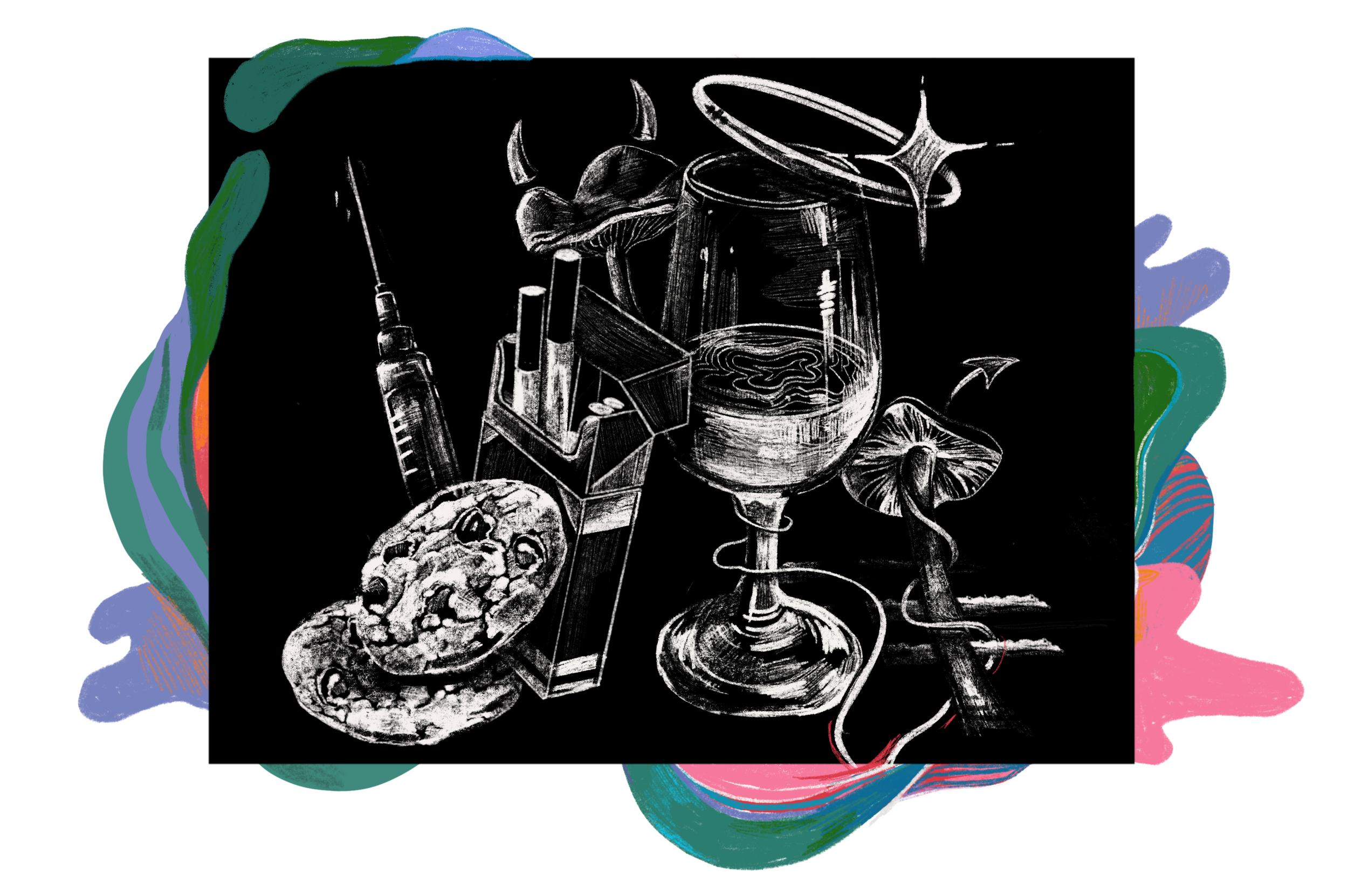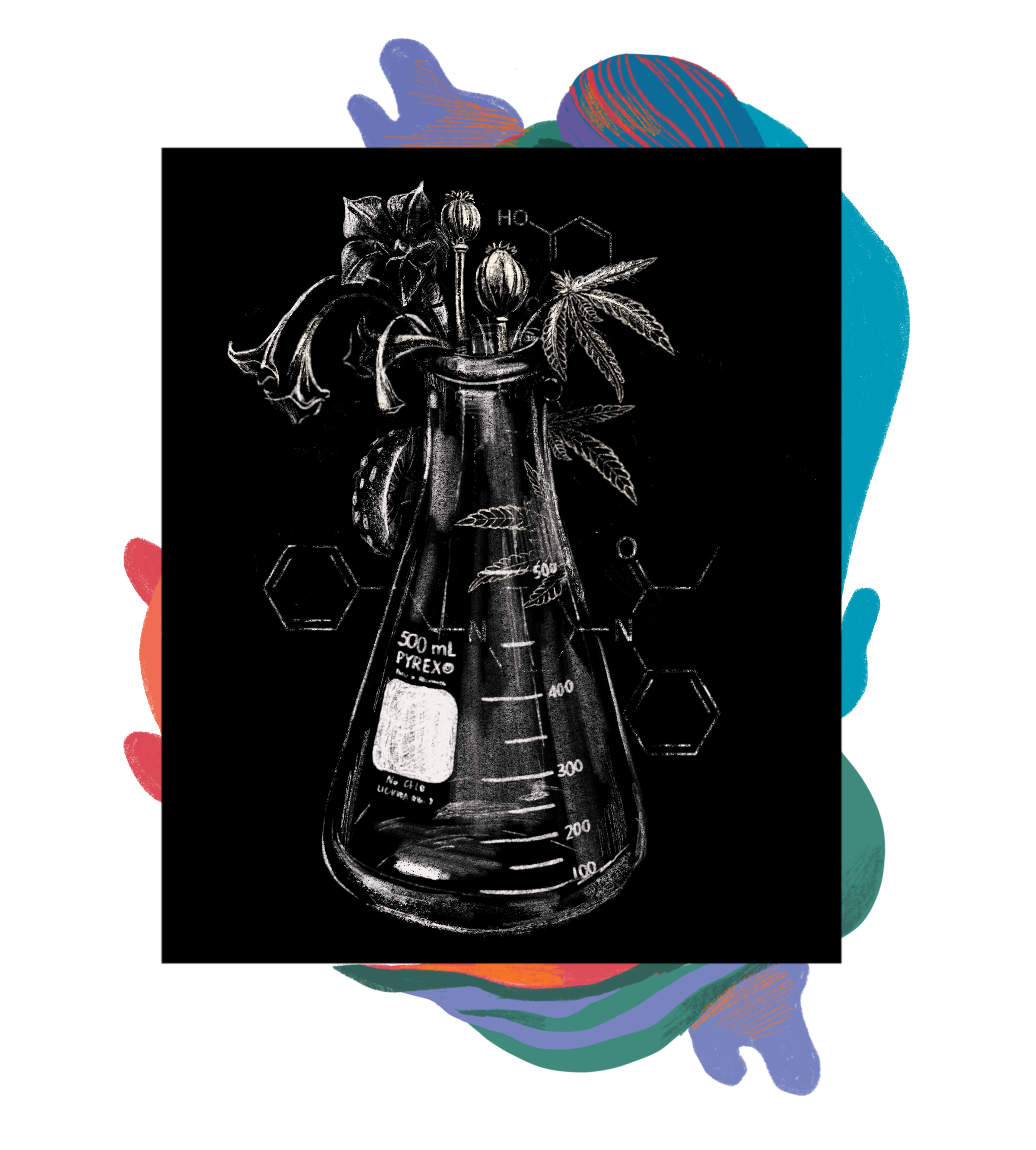There’s a saying in toxicology that “the dose makes the poison.” Attributed to German chemist Paracelsus, it means that anything, even water and oxygen, can either help or harm you, depending on the amount.
We’re all substance users, and everyone draws the line somewhere. Personal boundaries are based on physical, psychological, and legal factors, but they’re also influenced, subconsciously, by cultural narratives. With the recent news that President Biden is pardoning everyone convicted of cannabis possession under U.S. federal law and revisiting its classification, these seemingly fixed stories may be more malleable than we assume.
Just about every psychoactive substance, from mushrooms to cannabis and alcohol, has social, spiritual, medicinal, and cultural uses that stretch back millennia, some of which are still practiced today. Even the most maligned molecules, like morphine (from which the semi-synthetic opioid, heroin, is made), cocaine, and nicotine, must be viewed in a broader context to be understood. They’re the active constituents of the opium poppy, coca leaf, and tobacco plant, respectively: botanicals with complex histories.
Opium use, as sacrament and medicine, dates to the Neolithic age and spans the ancient world. The coca leaf has connected Andean people to ancestors, astronomical cycles, and each other through story, belief, and practice for more than 8,000 years. And tobacco remains not only a sacred “master plant,” but the main curing remedy of many Indigenous Amazonian peoples—so connected that the words for “tobacco” and “healer” are linked.
There’s a reason these substances are used medicinally. The opium poppy contains a range of alkaloids—molecules found in plants that produce physiological and/or psychoactive effects—that relieve pain, relax muscles, and aid sleep, including morphine and codeine. The coca leaf bears 13 natural alkaloids in addition to cocaine that, when consumed together in leaf form, are well-documented to benefit health, providing essential nutrients and used to ease nausea and altitude sickness. And tobacco, applied medicinally and often as a liquid, is used in Amazonia to treat intestinal problems, gout, and even respiratory illness.
Traditional uses of psychoactives were typically collective, part of rites of passage or cultural exchanges designed to promote healing, guidance, or spiritual connection. After all, altering consciousness—the way we interpret and experience the world—without a meaningful cultural container, one that connects the substance and its user to a broader cosmology, can be destabilizing or even deadly. But in many cases, that communal element was lost as the Global North began extracting these substances from their origins and contexts.
When European chemists isolated morphine and cocaine, they were, at first, seen as cure-alls for everything from infectious diseases to insomnia and depression, prescribed by doctors and found on the shelves of all social classes. They were even mixed with wine: cocaine in Mariani, opium in Sydenham’s Laudanum. Scientists called them “magic bullets,” the first time a plant’s activity was attributed to a single molecule. But research increasingly shows it’s the combination of alkaloids, taken together, that provides benefits, similar to how the entourage effect enhances the impact of cannabis compounds. Our bodies are better equipped to process whole plants, whereas isolated alkaloids are typically more potent and habit-forming. In communion, the molecules are medicine; in isolation, poison.
In 1914, the Harrison Act, pushed by Harry Anslinger—the racist head of the nascent federal Narcotics Bureau—outlawed opiates and cocaine based on manufactured fear and trumped-up testimonies. In turn, prohibition itself birthed illicit markets and the violence that comes along with them. The 1920s also brought the prohibition of alcohol and cannabis, and increasing restrictions led to increasing consequences. But it’s easier to blame the drugs and label people as criminals, addicts, or lunatics than it is to interrogate the culture they came up in; the systems that supported the emergence of these problems in the first place. Under the Global North’s imperialist model, immigrants, Black and Brown people, and the Global South became scapegoats, a dynamic that has persisted for centuries.
In the late 1800s, pulp novels and tabloids published stories about Chinese men seducing white women with opium, but the British and Europeans only supported snuffing out opium after losing their monopoly on trade, something the Chinese government had spent centuries fighting for. Cannabis legislation has always targeted Black and Brown people; even the words “marijuana” and “cannabis” have racist connotations. In 1949, a U.N. investigation into coca chewing cited “racial degeneration” as a reason to outlaw the practice. It paved the way for the 1961 U.N. Single Convention on Narcotic Drugs, expanded in 1971, which restricts all psychoactive substances today.
In the 1970s, Nixon’s “War on Drugs” ran with this framework, prompting decades of fear-based anti-drug campaigns rooted in disinformation—not only failing to distinguish isolated molecules from plants, but linking LSD to insanity and claiming that MDMA burned holes in your brain. The latter was based on scientific findings that were later proven false, only they didn’t run primetime TV ads for that retraction. A 2010 study by British drug scientist Dr. David Nutt explored the negative health outcomes of various psychoactive substances, and found the least harmful were MDMA, cannabis, and psilocybin; the most harmful were alcohol and tobacco, directly opposing U.S. and U.K. classification systems.
Biases against which substances feel “safe” to us persist today, and we think we know where they come from, but cultural and political programming have really been setting the terms. This fear was engineered, and it’s rooted not only in white supremacy, but also in the shame-based, puritanical religions and capitalist cultures of the Global North, which separated substance use from spirituality and turned consciousness-altering into a commodity.
The shaming, blaming mindset is reinforced regularly through language and practice. We call things that bring us emotional, spiritual, and social value “vices” and “guilty pleasures,” as if revelry and remorse can coexist. Our choices are painted as the existential struggle of good versus evil; us against the substances that control our bodies and minds. We build entire industries and certification programs around validating consumption of everything from alcohol to cheese. In Andean countries, distinguishing between varieties of mambe, or chewed coca, is as much an art as mastering wine is to a sommelier, but an accredited program isn’t required to enjoy it.
Yet these struggles are all rooted in fear of the unknown, which the dominant groups exploit; humans are wired to suspect difference and surprise. While we all want to alter consciousness in some shape or form, it’s natural to seek the predictable, acceptable high. Even though our legal substances bear great potential for harm—some medical experts posit refined sugar is a dangerous substance—in the Global North, we know what we’re getting with a beer, cigarette, or cookie. We have no context for things like psychedelics, whose very benefit lies in the fact that they are unpredictable, taking our default modes offline. With the proper framework, maybe they wouldn’t seem so scary.
Another study backed up Nutt’s harm rankings, but it also found that even the most potentially harmful substances offered hard-to-quantify benefits. Someone’s daily cigarette can relieve stress and even be a meditative practice: focusing on the breath, taking time away from the day, an excuse to reach out to a friend or go on a walk. Studies are exploring the potential of smokeless nicotine as a cognitive performance enhancer, as well, echoing the Amazonian belief that tobacco can “strengthen the mind.” After all, it’s the container that matters, from the method of administration (such as smoking versus tinctures) to frequency and the all-important set and setting.
If a cookie brings you joy, there is value in consuming it; eating a whole packet at once will make you sick. Sharing a few beers with friends can be a connective exercise, but binging every night is a different story. If you find yourself doing these things, perhaps you should avoid using a substance—yet while there are chemical contributors to overuse, even addiction must be viewed in context. Some psychologists are seeing it not as a cause, but a symptom; rather than a foible, they see it as a smart coping mechanism adopted by our child selves to deal with traumatic situations that would otherwise overwhelm us, and bring that compassionate lens to its treatment.
We’re scared of what we don’t understand—and even of substances we’re familiar with—because we’re told they’re bad, and we’re bad for using them. But I believe just about anything can be sacrament, medicine, or communion, and virtually anything can be abused. Morphine isn’t bad or good, it’s just a molecule. It’s what we do with it that matters.


